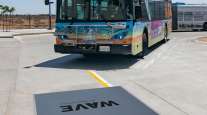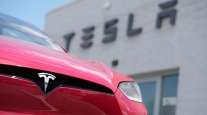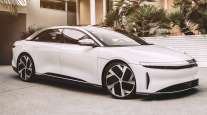Tesla Slow to Make Its Chargers Accessible to Other EVs
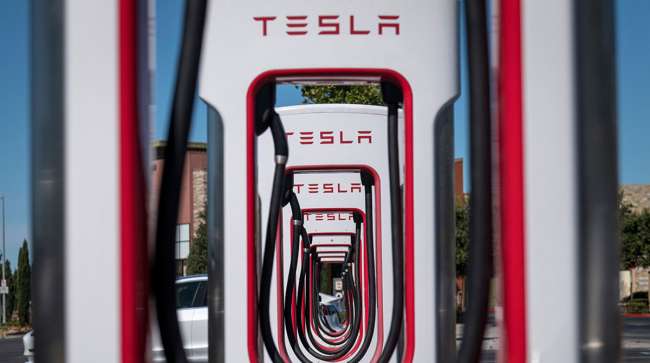
[Stay on top of transportation news: Get TTNews in your inbox.]
Tesla Inc. promised to drop the wall on its so-called charging “walled garden” two years ago, making its Superchargers accessible to all EVs. In turn, virtually every brand in the auto industry pledged to put Tesla ports in its electric vehicles.
Those commitments, once fulfilled, will make Tesla the standard for automobile plugs in America, particularly given Tesla’s reputation for its reliable, widespread network of EV fueling stations. But none of that is working yet for Mirriam Ferraro, 45, a nurse in Chapel Hill, N.C. Ferraro regularly drives her Kia EV6 to visit her sister in Wilmington, 160 miles away. Charging stations are sparse and the nine Tesla Superchargers on the way still don’t support cars like hers. Kia has promised a Tesla charging adapter for the EV6, but it won’t ship until January. Many carmakers are waiting for Tesla to send them adapters, so they can deploy them to their customers. When it does ship, Ferraro will have to pay for it.
“It will be worth it,” she says. “I absolutely love the car, but it’s definitely limited my travel.”
Tesla “invited” other brands to adopt its charging port in late 2022. A few months later, it went a step further, promising to retrofit its stations for Chevys, Fords and other brands of electric vehicles that didn’t have a Tesla port, though it never provided a timeline. That month it started installing something dubbed the Magic Dock, a sleek retrofit that worked for cars that didn’t have a Tesla port or adapter. Yet today, only about 100 of the company’s 2,500 or so U.S. Supercharger stations feature the Magic Dock, according to a Bloomberg Green analysis.
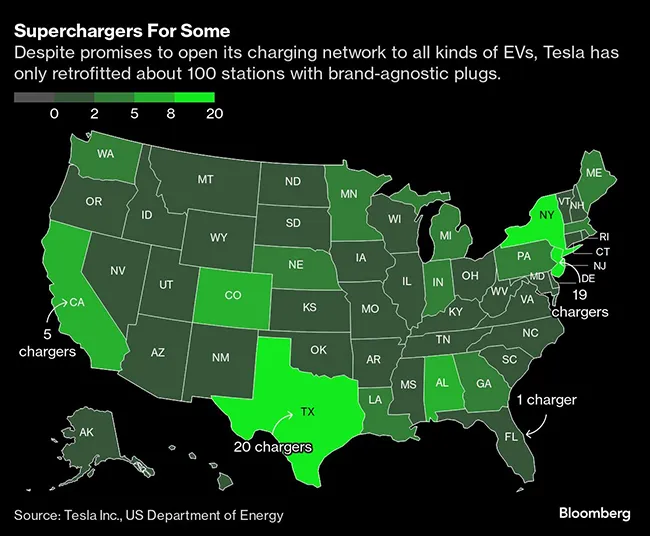
Huge swaths of the country are still off the Tesla charging map, with nary a retrofitted Supercharger in sight for more than half of all states. And there seems to be little rhyme or reason behind the Magic Dock rollout. California, far and away the country’s EV leader, only has five stations with the adapters, while Florida, another electric hot spot, has a single Supercharger converted. Texas leads the country with 20 Magic Docks and they’re around every corner in New Jersey, but Oregonians are out of luck. What’s more, many of the Magic Docks were taken offline this fall.
“Tesla has not kept its promise,” said Conrad Layson, a senior analyst at AutoForecast Solutions. “Tesla has given no reason for the delay in deploying more Magic Docks. Nor have they commented on (the) inability to follow-through on their promise.”
The company also did not respond to interview requests for this article.
In truth, Tesla hasn’t seemed too concerned about improving Supercharging for Teslas, let alone other kinds of vehicles. In April, Tesla fired its nearly 500 employees who worked on Supercharging. Some were eventually rehired. There still aren’t enough people to keep the system up and running, according to Layson.
Starting next year, virtually every brand of electric vehicle will roll out of the factory with a Tesla port, dubbed the North American Charging Standard, or NACS. In the meantime, there is a huge crowd of drivers like Ferraro who bought too early to get a Tesla port and are scrambling for adapters, which are expensive and have been delayed, largely because Tesla is handling that hardware as well.
The loss of so many Supercharger workers at Tesla “certainly didn’t help,” said Brent Gruber, executive director of the EV practice at J.D. Power. “A lot of those people were working with these other auto manufacturers on these transitions.”
John Elliott of Load One demonstrates how onboard video combined with AI-enabled analytics can transform fleet safety. Tune in above or by going to RoadSigns.ttnews.com.
Tesla drivers aren’t happy about the state of Supercharging either, including the prospect of interlopers. Satisfaction scores have swooned, according to J.D. Power’s ongoing survey. “We got a lot of comments from people who were none too pleased when a Ford F-150 Lighting was next to them taking up two spaces,” Gruber explained.
Ultimately, the Supercharger kerfuffle will be short-lived, as more chargers from other networks come online and Tesla ports and adapters finally show up en masse in non-Tesla vehicles. In the past couple of years, rival networks have far outstripped Elon Musk’s charging empire. For every Supercharger station in the U.S., there are now almost three public fast-charging stations operated by other companies. Those networks — including EVgo Inc. and ChargePoint Holdings Inc. — already have plugs for Tesla ports and are hastily adding more.
Furthermore, the potential to tap into Tesla chargers has emboldened EV-curious drivers to buy battery-powered rigs from Ford, General Motors and other brands. In opening its charging network 11 years after it started building it, Tesla essentially traded a powerful sales incentive for a revenue stream from other vehicles; it is becoming slightly less of a car company and slightly more of a utility.
“I don’t think that can be emphasized enough,” Gruber said. “You eliminate the advantage (Tesla) had with the charging network. … And Tesla products are aged at this point.”
That said, Tesla may harvest as much as $3 billion a year from charging other companies’ cars by 2030, according to Piper Sandler & Co. And Tesla owners charging at Tesla stations are by far the happiest respondents in J.D. Power’s satisfaction survey. Non-Tesla owners charging at Tesla stations come in second with all the other networks scoring lower.
Want more news? Listen to today's daily briefing above or go here for more info
“By improving the charging experience and making EVs more attractive,” says BloombergNEF analyst Ash Wan, “EV adoption will be pushed forward in the U.S., which will be good for Tesla.”
When Ferraro finally gets her Tesla adapter sometime in the new year, she’ll have scads of charging options. For the time being, however, she’s not going to drive to visit friends in Washington, D.C. And when she goes to her sister’s place, Ferraro is going to stay a little longer, while her car sips electrons from a standard outlet.
“It’s frustrating,” she says, “but I still absolutely love driving by a gas station.”



